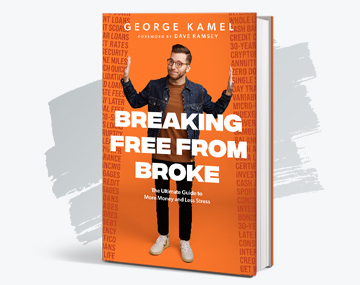Key Takeaways
- Fingerhut is an online retailer that requires customers to use credit (aka debt) to pay for items in monthly installment plans.
- Their products are often more expensive than similar items at other retailers, meaning you’ll pay more than necessary.
- Their financing plans can stretch payments over long periods, causing you to pay far more than the original price due to interest and fees.
What’s up with Fingerhut? A lot of shady stuff, that’s what.
Pay off debt fast and save more money with Financial Peace University.
On the surface, it may seem like a great way to snag a new TV or karaoke machine for a good price. And as much as I want to sing a duet of “Total Eclipse of the Heart” with you, I also want you to make good decisions with your money. Don’t be distracted by Fingerhut’s digital pile of stuff or their promise to help you build credit. Shopping with Fingerhut is actually a quick way to get trapped in a cycle of debt.
If you’re still not sure about these guys, I’ve done the research for you. Keep reading for a rundown on how Fingerhut operates and why you should steer clear of this credit con artist.
What Is Fingerhut?
Before we get too far into this review, I’ve got to address the elephant in the room. The name Fingerhut is straight-up weird. Is it like Pizza Hut . . . but for fingers? Yuck. Not the mental image you want to associate with a brand. Just know I’m cringing every time you read that name.
Okay, now that that’s out of the way, let’s get down to business. What is Fingerhut and what are they about?
Basically, Fingerhut is an online retailer that uses buy now, pay later (BNPL). It was started back in 1948 by William Fingerhut (okay, that explains the name, but I still wish someone would’ve raised a flag in the marketing meeting) as a way to sell automobile seat covers. It later became a mail-order catalog company and eventually grew into what it is today—a massive shopping site that forces you to finance.
What does that mean? Well, with a typical BNPL plan, you could purchase a sweater on, say, Target’s website with the option to break up the cost into several payments (through a third-party like Afterpay, Klarna or Affirm). But with Fingerhut, you have to buy directly from Fingerhut’s online inventory. They carry everything from jewelry and clothing to electronics and kitchen tools by some of your favorite name brands.
But there’s a catch. Fingerhut won’t let you buy anything from them outright. Because that would be too easy. Nope, your only option is to apply for a Fingerhut credit account and get approved to make monthly payments on the thing you want. Because who doesn’t love paying for an above-ground swimming pool well into the middle of winter?
Installment plans like Fingerhut’s are getting more popular. In fact, our Ramsey research found that around 21% of people use buy now, pay later services.
Yeah, it might sound like a helpful option if you can’t afford to pay cash for that new pair of shoes or furniture set. But just because you’re paying less up front, it doesn’t mean you’re getting a good deal.
There’s actually a lot of sneaky things happening behind the paywall that Fingerhut doesn’t want you to know about. Let’s take a closer look at how their credit system works and why doing business with Fingerhut is more dangerous than doing business with Jabba the Hutt.
More Money. Less Stress. Yes, Please.
In his new book, George Kamel does the research for you and exposes all the worst money traps out there so you can build real wealth!
How Do Fingerhut Credit Accounts Work?
You’re browsing the Fingerhut site when you spot the trampoline that will make all your kids’ (and let’s be honest, your) summertime backyard dreams come true. And right next to the picture, you see two prices: the actual cost of the trampoline and the advertised price per month (aka what your monthly payment might be).
Hm. $46.99 a month? I can do that, you think. Click. Add to cart. But not so fast! First, you must pass the Fingerhut credit test. (Yeah, it’s more annoying than those “prove you’re not a robot” tests.)
Here’s how it works:
1. You apply for Fingerhut Credit and receive an offer.
Credit is the currency of choice for Fingerhut, and they use a company called WebBank to issue it. Just like any other bank or credit card company, WebBank will check your credit to see if you qualify. Once you’ve been approved, then you can actually buy (and by “buy,” I mean “make payments on”) that trampoline you want so much. It’s kind of like having a store credit card—and just as bad.
Depending on your credit history, you’ll either be sold a Fingerhut Fetti Credit Account (no relation to Funfetti, which is way more fun) or a Fingerhut FreshStart Credit Account. The Fetti account is basically a revolving line of credit where you borrow up to your spending limit and then get a bill to pay it back each month. And the FreshStart account is an installment loan (mostly marketed to people with poor credit) where you make a one-time purchase of $50 or $100 and pay it off each month for six to eight months.
2. You shop the site and see what your monthly payment will be.
After Fingerhut decides you’re “worthy” enough to buy from them, you can see what your monthly payment will actually be for each item. But according to Fingerhut’s own numbers, you could end up forking over almost $700 total—for a trampoline that originally cost $490! (And that doesn’t even include any extra interest you might pay if you get behind on payments.)
If that sounds like a good deal to you, you need to get your hearing checked.
3. You snag your item... and pay on it forever.
Okay, so let’s say you decide to get that trampoline with your Fingerhut Fetti account. Yeah, you now have a fun way to pass the time, but you’re also going to be paying it off for the next 18 months. Pretty soon, that monthly bill will start to feel more painful than your lower back after trying to impress your kids with a back flip (and failing).
And that’s if you just buy one thing! Chances are, you’ll get suckered into buying more backyard “necessities”—like a kiddie pool and a hammock and a new grill. And before you know it, you’re juggling multiple payments on multiple items for years, paying literally hundreds of dollars more than if you’d just paid in cash. Are you starting to see just how tricky Fingerhut is?
Don’t Let Fingerhut Fool You
They’re Overpriced
Listen, I love an online deal as much as the next person. But a lot of the stuff you’ll see on Fingerhut’s site is actually way more expensive than other sites! They just rely on you being so excited about the advertised monthly payment that you don’t notice you’re being ripped off as you impulsively sign up for the payments.
Fingerhut’s goal is to get you to think you can afford to buy something without really counting the true cost. They say they help you “get the credit you deserve.” But do you really deserve to be in debt up to your eyeballs over stuff you don’t really need? (That’s rhetorical. The only acceptable answer is no.)
The whole thing is like a mousetrap—and you’re the mouse. Except instead of cheese, they lure you in with Keurigs, fitness machines and dehumidifiers (seemingly for a fraction of the retail price). But just like the mouse, you’re not seeing the full picture until it’s too late and SNAP! You’re caught beneath a pile of payments. And worst of all, there ain’t even cheese in this trap.
Their Interest Is Ridiculous
On their website, Fingerhut brags about having no hidden fees. But you do have to do some digging to find out exactly what those fees are—and that their Annual Percentage Rate (APR) is a whopping 29.99% for the Fetti account! And listen, I hate credit cards, but that’s way more than the average credit card interest rate of 16.17%.1 Yikes.
Plus, you could also get stuck with extra fees if your payment bounces or if you miss a due date. And research shows that most people who use BNPL services had trouble maintaining their payments. Which means most people are probably paying those late fees, plus interest!
They Target People With Poor Credit
Fingerhut preys on people by offering credit to those who are already struggling with debt. Here’s how they do it: “Even if you have been turned down for credit, give us a try. We can often say ‘Yes!’ when others say no. . . . We work with people every day who have (or had) credit challenges and we look forward to working with you!”
I’m sure you do, Fingerhut. I’m sure you do.
Because if they can get people who are already known to miss payments to sign up for a Fingerhut credit account, then they can collect even more interest and profit from their bad spending habits. That’s messed up.
Bottom line: Don’t let the so-called “discounts” deceive you. If you buy anything through Fingerhut, you will pay more in the long run.
Forget Fingerhut and Take Control of Your Money
You’ve probably heard people say that if you can afford the payment, you can afford the item. That’s broke-people talk. That way of thinking will only have you juggling payments, paying a ton in interest, and always feeling behind with your money. It’s a system that’s rigged from the start. But it doesn’t have to be that way!
I want you to own your stuff instead of your stuff owning you. And that starts with changing the way you think about money.
If you’re ready to stop the credit cycle and take control of your spending for good, Financial Peace University (FPU) will show you how. In this video course, you’ll learn everything you need to know about saving money, paying off debt, and building wealth for the future.
Plus, there’s a lesson called “Wise Spending” where I walk you through all the traps and tactics companies use to get you to part with your hard-earned money, including buy now, pay later.
Start watching FPU right now! Because when you’ve got a game plan for your money, you’re more likely to stay on track and not let the Fingerhuts of the world derail your spending.




